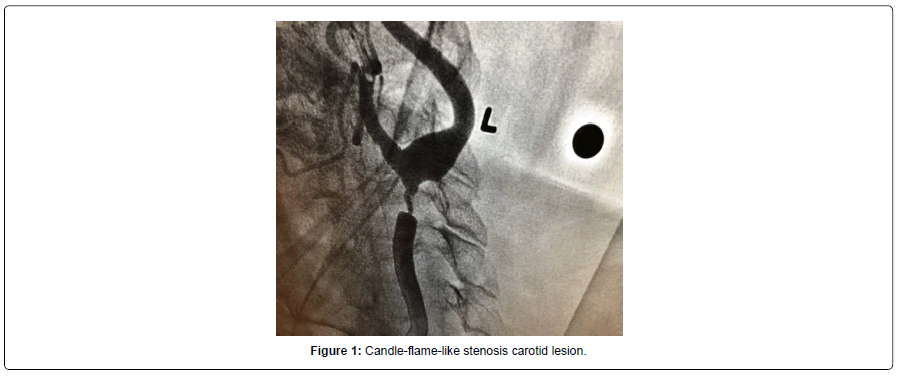Clinical Image, J Clin Image Case Rep Vol: 4 Issue: 2
Candle-Flame-Like Stenosis Carotid Lesion
Nasser Maher1*, Calderon Evelyn2 and Kurtca Miray3
1Clinical Professor, Baylor College of Medicine, Consultant Cardiologist, Baylor St. Luke’s Medical Center, CHI Health System, Texas Heart Institute, HCA Healthcare, and Houston Methodist Hospital, Texas.
2Faculty of Medicine, University of Guayaquil, Av. Delta y Av. Kennedy, Guayaquil, Guayas.
3Faculty of Medicine, Dokuz Eylul University, Turkey.
*Corresponding Author: Nasser Maher
Clinical Professor, Baylor College of Medicine, Consultant Cardiologist, Baylor St. Luke’s Medical Center, CHI Health System, Texas Heart Institute, HCA Healthcare, and Houston Methodist Hospital E-mail: mmnmd.1970@gmail.com
Received: May 20, 2020 Accepted: October 28, 2020 Published: November 04, 2020
Citation: Maher N, Evelyn C, Miray K (2020) Candle-Flame-Like Stenosis Carotid Lesion. J Clin Image Case Rep 4:3. doi: 10.37532/jcicr.2020.4(3).134
Abstract
An 87-year-old male retired lawyer who came to our outpatient clinic and reported expressive aphasia, weakness in the right upper extremity, and inability to write as normal. Symptoms were highly suggestive of TIAs. On physical examination, he had a loud left carotid bruit. Carotid Doppler suggested a high-grade lesion of left common Carotid Artery. Carotid angiogram showed a severe candle-flame-like narrowing in the left common carotid artery that extended to the bulb area with post stenotic dilatation (Panel A). The patient underwent successful left carotid endarterectomy with no complications and no recurrence of TIAs symptoms on further follow-up
Keywords: Candle-Flame, Stenosis, Carotid Lesion
Case Report
An 87-year-old male with symptoms highly suggestive of TIAs underwent a Carotid Doppler that showed a high-grade lesion of left common Carotid Artery. Carotid angiogram showed a severe candleflame- like narrowing in the left common carotid artery. The patient underwent successful carotid endarterectomy with no complications and no recurrence of symptoms.
An 87-year-old male retired lawyer who came to our outpatient clinic and reported expressive aphasia, weakness in the right upper extremity, and inability to write as normal. Symptoms were highly suggestive of TIAs. On physical examination, he had a loud left carotid bruit. Carotid Doppler suggested a high-grade lesion of left common Carotid Artery. Carotid angiogram showed a severe candle-flame-like narrowing in the left common carotid artery that extended to the bulb area with post stenotic dilatation (Panel A). The patient underwent successful left carotid endarterectomy with no complications and no recurrence of TIAs symptoms on further follow-up.
TIAs are short events of neurologic function alteration caused by a regional reduction in blood flow to the brain without permanent sequels [1,2]. Strokes can cause long-term disability and death. Death rate increases with subsequent strokes, which often occur within one year of the first attack. TIAs and strokes can be caused by blockages and severe stenosis of carotid arteries. Carotid endarterectomy may reduce the possibility of repeated episodes of TIAs, as well as stroke and its complications, including death in patients with severe carotid occlusion [3].
References
- Donald Easton J (2009) Definition and Evaluation of Transient Ischemic Attack. Stroke 40: 2276- 2293.
- Coutts SB (2017) Diagnosis and Management of Transient Ischemic Attack. Continuum 231: 82-92.
- Rerkasem K, Rothwell PM (2011) Carotid endarterectomy for symptomatic carotid stenosis. Cochrane Database Syst Review.
 Spanish
Spanish  Chinese
Chinese  Russian
Russian  German
German  French
French  Japanese
Japanese  Portuguese
Portuguese  Hindi
Hindi 
